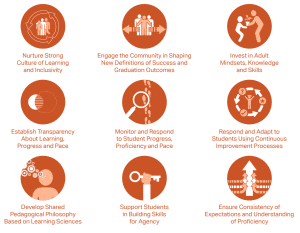Step by Step Our Field Builds Its Capacity for Diversity, Equity, and Inclusion
CompetencyWorks Blog

At iNACOL a few weeks ago, people from three different organizations came up to me to tell me about their progress in building organizational capacity around diversity, equity, and inclusion (DEI). Some are making steps in building diverse candidate pools that are leading to greater diversity on staff. Some are starting to use an equity lens to review decisions. Some are turning the equity framework developed through the National Summit on K-12 Competency-Based Education into tools to use with their networks.
I think a good example of how our field is moving step by step (let’s be honest, there are still way too many panels of all white people or equity added as the last bullet point rather then integrated into the core of our work) is from NGLC. In their latest Practitioner Guide, they recount their story toward building their organizational capacity around equity:
Even though we’re a small team, we benefited from a variety of expertise and coaching experiences. Specifically, we accessed professional learning through the National Equity Project; contracted with Caroline Hill (now at The 228 Accelerator); and this past year joined the Promise 54 Accelerator. Each of these resource types can provide essential tools for your team’s growth and support change of practice. Each one is also a cohort learning experience or community of practice with additional benefits well beyond the content and tools that are shared. You can also search for consultants at the newly created Catalyst DEI Expert Hub.
They also shared a number of resources they developed or are finding helpful:
- The Designing for Equity Professional Learning Toolkit and Discussion Protocols from the NGLC website offer a collection of protocols, professional learning experiences, and other resources from members of our network, including CityBridge, School Reform Initiative, and New Schools for New Orleans.
- “Changing the Discourse in Schools” explores how the ways we use language in schools is often structured to perpetuate the dominant culture rather than support the needs and interest of students. It also includes a graphic that depicts examples of Discourse 1 and Discourse 2.
- “Pursuing Social and Emotional Development Through a Racial Equity Lens: A Call to Action,” a publication from The Aspen Institute, makes the case for and provides recommendations about implementing social, emotional, and academic development (SEAD) with a racial equity lens, rather than treating equity and social-emotional learning as separate efforts.
- The norms included in “Four + Agreements for Courageous Conversation” from Fellowship for Race & Equity in Education (FREE) supported the NGLC team as we reflected on and discussed issues of diversity, equity, and inclusion.
- Learning With Others, a report from JFF’s Student-Centered Learning Research Collaborative and American Institutes for Research (AIR), shares findings on the relationship between collaboration, personalization, and equity.
Bravo to all of you who are taking DEI seriously. We are making progress. It makes me smile to imagine a rich field of personalized, competency-based learning with equity at its core and where the leaders reflect the beauty and knowledge from across the cultures and communities of our nation.
See also: